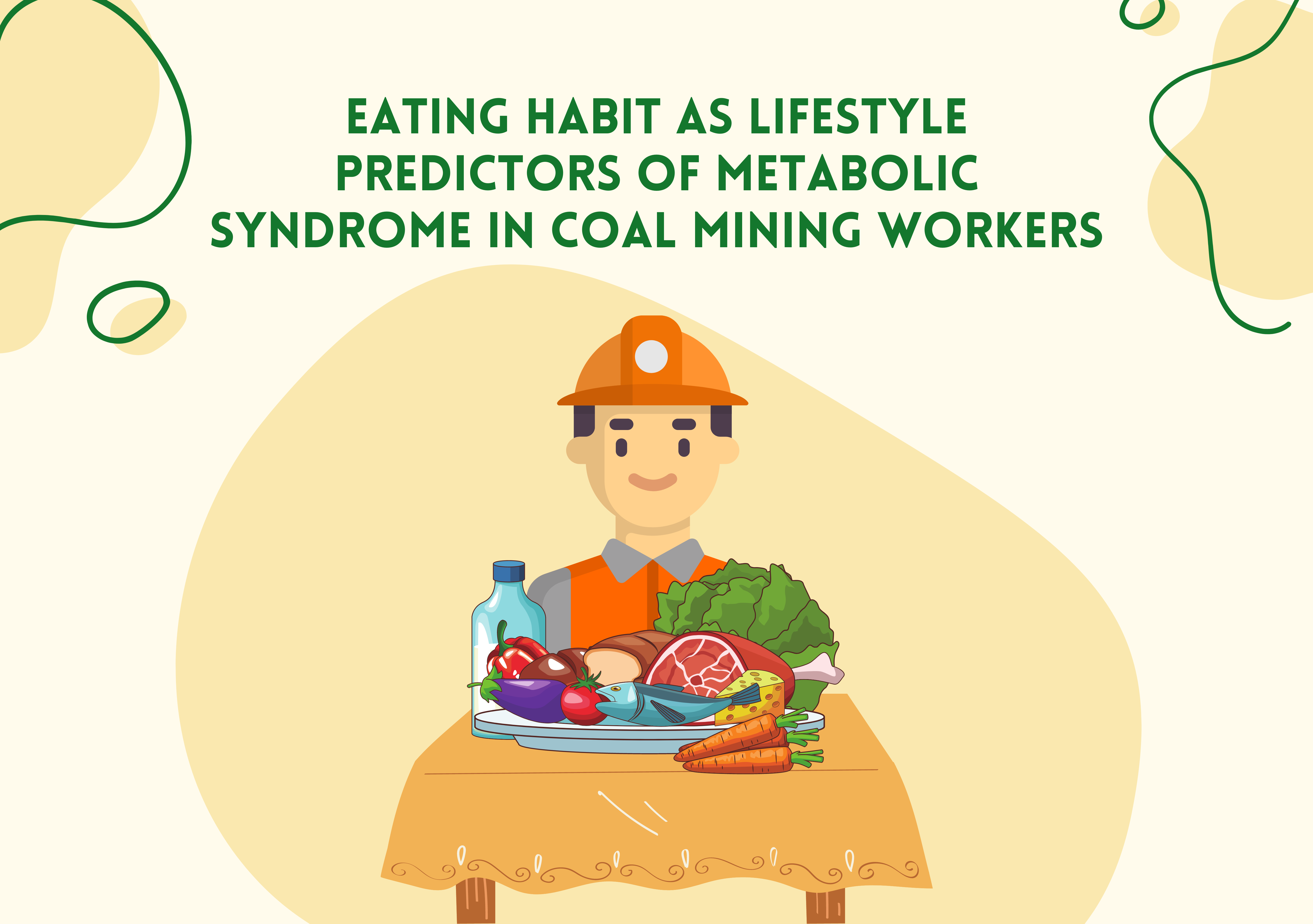Eating Habit as Lifestyle Predictors of Metabolic Syndrome in Coal Mining Workers

Downloads
Introduction: Previous study was carried out in a company, obtaining the prevalence of metabolic syndrome cases by 21.58% with non-communicable diseases as the indicator. The cause of the metabolic syndrome is critical to understand in order to reduce the impact of acute non-communicable diseases. Excessive food consumption and low physical activity in office workers and coal mining workers are two risk factors that contribute to the development of metabolic syndrome. Therefore, current research was conducted aiming to identify the lifestyle aspects related to metabolic syndrome in coal mining companies in South Kalimantan. Methods: This study was carried out through analytical observational cross-sectional research. In this case, the data were collected using questionnaires. Exercise routines, cigarette smoking, and meal frequency were the research factors. In South Kalimantan, there are up to 70 employees of mining company, and 22 people of them were selected as the research subjects through purposive random sampling and inclusion criteria. Results: The indicators of metabolic syndrome in most of the respondents showed normal state. However, a small number of respondents were at risk of having the indicators of metabolic syndrome. Meanwhile, based on the statistical analysis, there is a lifestyle factor that correlates with the frequency of eating coconut milk-based chicken curry (1-2 times/week) with metabolic syndrome (p=0.045). Conclusion: Types of food cooked using coconut milk can trigger a person to have a risk of experiencing one or several of the metabolic syndrome indicators. Things that can be done to reduce the risk of metabolic syndrome associated with the frequency of habit of eating high-fat animal side dishes, including reducing the frequency of such food at night.
Abu Bakar, N. A. F., et al. (2022). Association between a Dietary Pattern High in Saturated Fatty Acids, Dietary Energy Density, and Sodium with Coronary Heart Disease. Scientific Reports, 12(1), 13049.
Ekanayaka, R. A., et al. (2013). Impact of a Traditional Dietary Supplement with Coconut Milk and Soya Milk on the Lipid Profile in Normal Free Living Subjects. Journal of Nutrition and Metabolism, 2013, 481068.
Fahed, G. et al. (2022) ‘Metabolic Syndrome: Updates on Pathophysiology and Management in 2021', International Journal of Molecular Sciences, 23(2), pp. 1–38.
Ha, K., and Song, Y. (2019). Associations of Meal Timing and Frequency with Obesity and Metabolic Syndrome among Korean Adults. Nutrients, 11(10), 2437.
Ismiati, T. T. (2021) Analisis Faktor yang Mempengaruhi Tekanan Darah Karyawan Operator Tambang di Tenggarong Seberang.Jurnal Keperawatan Dirgahayu, 3(2), pp. 18–22.
Nisa, M. A., Martiana, T. and Wahyudiono, Y. D. A. (2018) ‘Analysis of Relation between Life Style, Workload, and Work Stress with Metabolic Syndrome', Indian Journal of Public Health Research and Development, 9(5), pp. 53–58.
Novela, V. (2019) Hubungan Konsumsi Zat Gizi Mikro Dan Pola Makan Dengan Kejadian Obesitas. Jurnal Human Care, 4(3), pp. 190-198
Ministry of Health Republic of Indonesia. (2018). Main results 2018 national health survey report. (In Bahasa)
Setyowati, P (2013). ‘Pengaruh Frekuensi Perebusan terhadap Kandungan Asam Lemak Tidak Jenuh Santan Kelapa'. Theses, Universitas Brawijaya
Driyah, S. et al. (2019). Prediktor Sindrom Metabolik: Studi Kohor Prospektif Selama Enam Tahun di Bogor, Indonesia. Media Litbangkes, 29(3), pp.215 – 224
Simatupang, B. S. A. and Siregar H. H. (2019). "Korelasi Mengkonsumsi Makanan Bersantan Pada Suku Melayu Dengan Penyakit Hypertensi Di Desa Pertumbukan Kecamatan Stabat Kabupaten Langkat'. Prosiding Seminar Nasional III Biologi dan Pembelajarannya Universitas Negeri Medan.
Wennberg, M., et al. (2016). Irregular Eating of Meals in Adolescence and the Metabolic Syndrome in Adulthood: Results from a 27-year Prospective Cohort. Public Health Nutrition, 19(4), 667–673.
Wiardani, N. Kusumajaya, A. and Arsana, I. (2018). Macronutrient Intake and Metabolic Syndrome Status towards Tour Guide. International Journal Of Health Sciences (IJHS), 2(1), pp.29-43.
Yoshida, J., et al. (2018). Association of Night Eating Habits with Metabolic Syndrome and its Components: a Longitudinal Study. BMC Public Health, 18(1), 1366.
Tim dokteranda. 2012. ‘Seputar diet, makanan, dan suplemen'. Jakarta Pusat: Penebar Plus
Wang J., et al. (2020) Development and Internal Validation of Risk Prediction Model of Metabolic Syndrome in Oil Workers. BMC Public Health, 20 (1828): 1-12.
Zahra, Y. A. and Riyadi, H. (2022) ‘Status Gizi , Aktivitas Fisik dan Produktivitas Kerja Karyawan Tambang Batu Bara PT . Kaltim Prima Coal', Jurnal Ilmu Gizi dan Dietetik, 1(1), pp. 34–41.
Zahtamal et al. (2014) Prevalensi Sindrom Metabolik pada Pekerja Perusahaan T. Jurnal Kesehatan Masyarakat Nasional, 9(2), pp. 113–120.

This work is licensed under a Creative Commons Attribution-NonCommercial-ShareAlike 4.0 International License.

In order to be accepted and published by The Indonesian Journal of Occupational Safety and Health, Author(s) who submit an article should complete all the review process. The copyright of received articles assigned to the The Indonesian Journal of Occupational Safety and Health and Department of Safety and Health, Universitas Airlangga as publishers of the journal. The intended copyright includes the rights to publish articles in various forms (including reprints).
The Editorial Team of The Indonesian Journal Of Occupational Safety and Health and Department of Safety and Health strive to ensure that no errors occur in the articles that have been published, both data errors and statements in the article.
Users of this website will be licensed to use materials from this website following the Creative Commons Attribution-NonCommercial-ShareAlike 4.0 International License. No fees charged. Please use the materials accordingly.
------------------------------------------------------------------------------------------------------------------------------------------------------------------------------------------
Attribution ” You must give appropriate credit, provide a link to the license, and indicate if changes were made. You may do so in any reasonable manner, but not in any way that suggests the licensor endorses you or your use.
NonCommercial ” You may not use the material for commercial purposes.
ShareAlike ” If you remix, transform, or build upon the material, you must distribute your contributions under the same license as the original.







 How to Submit Articles in OJS
How to Submit Articles in OJS

























